By CL Huffard, B Davis, Y Takeshita, KL Smith, Jr., Monterey Bay Aquarium Research Institute
Summary
Two AquapHOx®-LX loggers with Robust Screw Cap Probes (PHROBSC-PK8T-SUB) were obtained from Ohio Lumex in May 2021. Performance was tested in the laboratory by comparison with the mFET and laboratory standards the same month. The pH values measured by the AquapHOx in the laboratory were comparable to those measured by other methods. These loggers were then deployed in ROV test dives, and at abyssal depths (3963 m deep) along the California coast from October 2021 to September 2022. Short-term variability was evident. Over the course of the long-term deployment, pH gradually drifted upward.
While offsets and drift during short- and long-term deployments will need to be better understood, it was concluded that the AquapHOx-LX loggers with Robust Screw Cap Probes are useful for understanding changes in pH at abyssal depths.
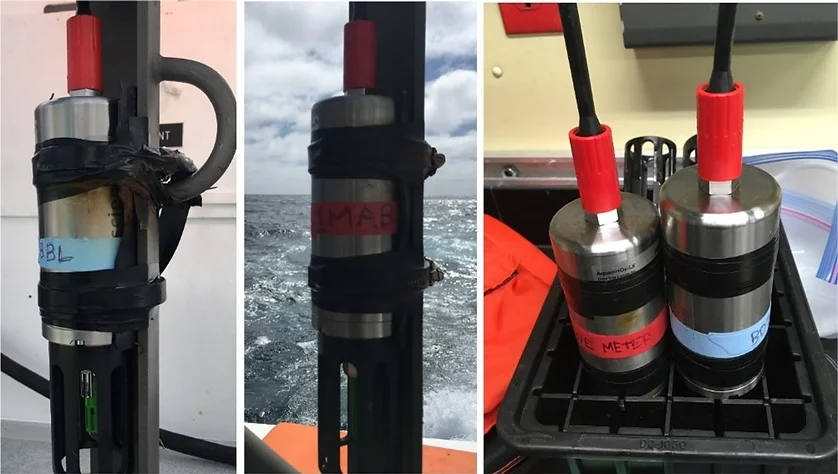
Laboratory comparisons
One AquapHOx-LX logger with Robust Screw Cap Probe was calibrated according to the operation manual, and the other was used as it arrived from the manufacturer for comparison. Both units were then placed in a 5-gallon bucket of seawater (10-14 °C), along with an mFET plugged into a laptop and providing a live feed of data (Figure 2). pH was modified by the addition of 1 M HCl and 1 M NaOH in small quantities, as monitored using the mFET data feed. Water was stirred for approximately 1 minute with each pH change. At incremental periods, water samples were taken from the bucket for laboratory analysis of pH using spectrophotometry with purified meta-cresol purple. The AquapHOx sensors yielded pH values comparable to those measured by the mFET and laboratory analysis (Figure 3).
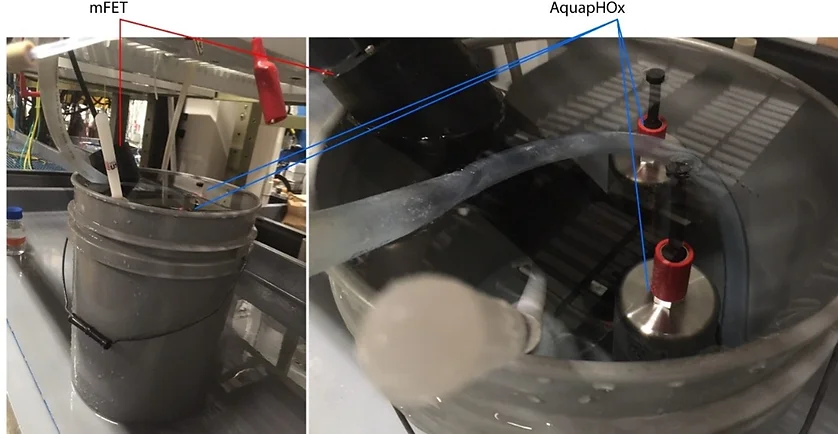
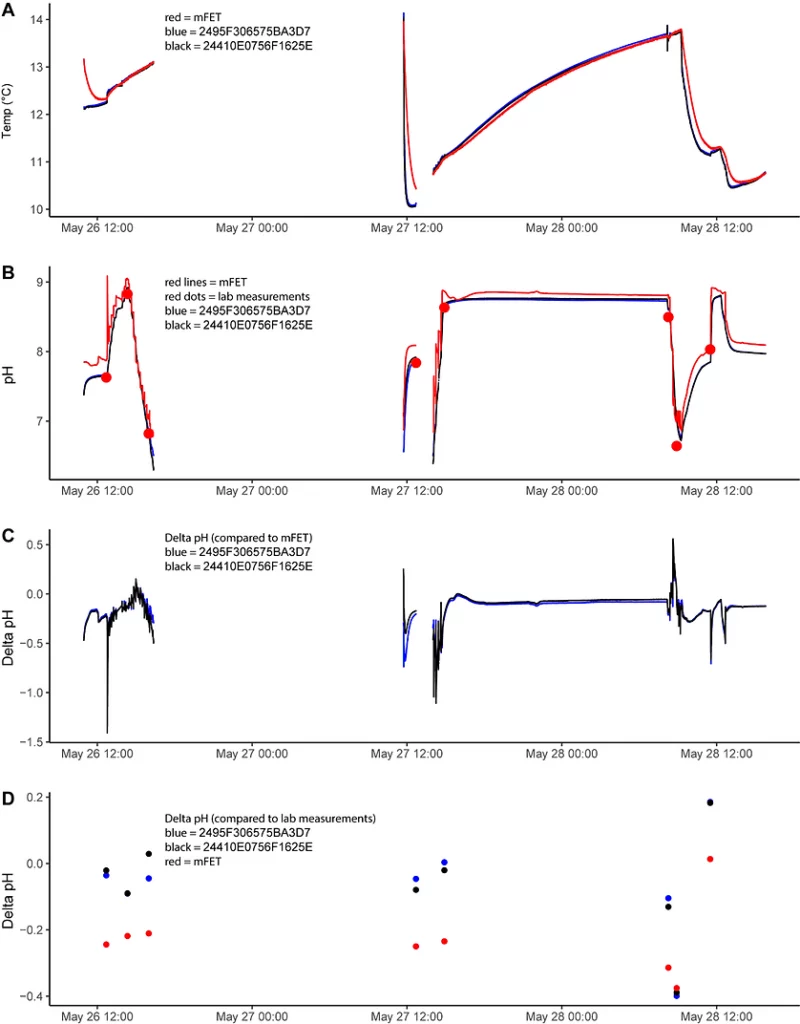
Deep-sea deployments
A) ROV test dives
Two AquapHOx-LX loggers with Robust Screw Cap Probes were deployed in the deep sea to test suitability of these instruments for in-situ measurement over long deployments. To ensure the sensors were water-tight, they were first deployed on a lander sent to approximately 800 m depth (September 2021, Monterey Bay, California). After passing this test, they were brought to Station M (NE Pacific), calibrated, and sent down in a drawer on the ROV Doc Ricketts. This drawer clearly prevented free water exchange to the AquapHOx-LX loggers with Robust Screw Cap Probes, but the loggers nonetheless attained temperature values comparable to the ROV CTD, and patterns of pH change similar to each other (Figure 4). Although both sensors were calibrated prior to deployment and deployed side-by-side, one sensor recorded higher values than the other (Figure 4C).
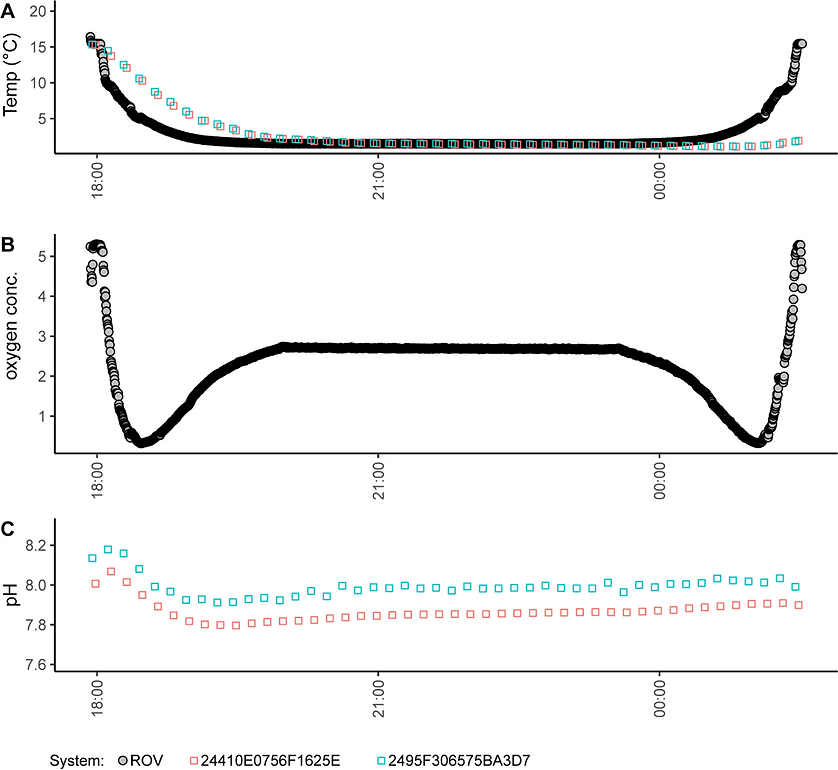
B) Long-term deployment
Following successful data collection during ROV test dives, our plan was to deploy the sensors for one year on the Benthic Rover II. Unfortunately, problems with weather and the ship’s engine forced a change in plans. Unsure whether a replacement cruise would be available for deployment of the Benthic Rover at a later date, we deployed the AquapHOx-LX loggers with Robust Screw Cap Probes on a titanium time-lapse camera frame so that one sensor would sit just above the sediment, and the other would sit 1 m above the seafloor (Figure 5).
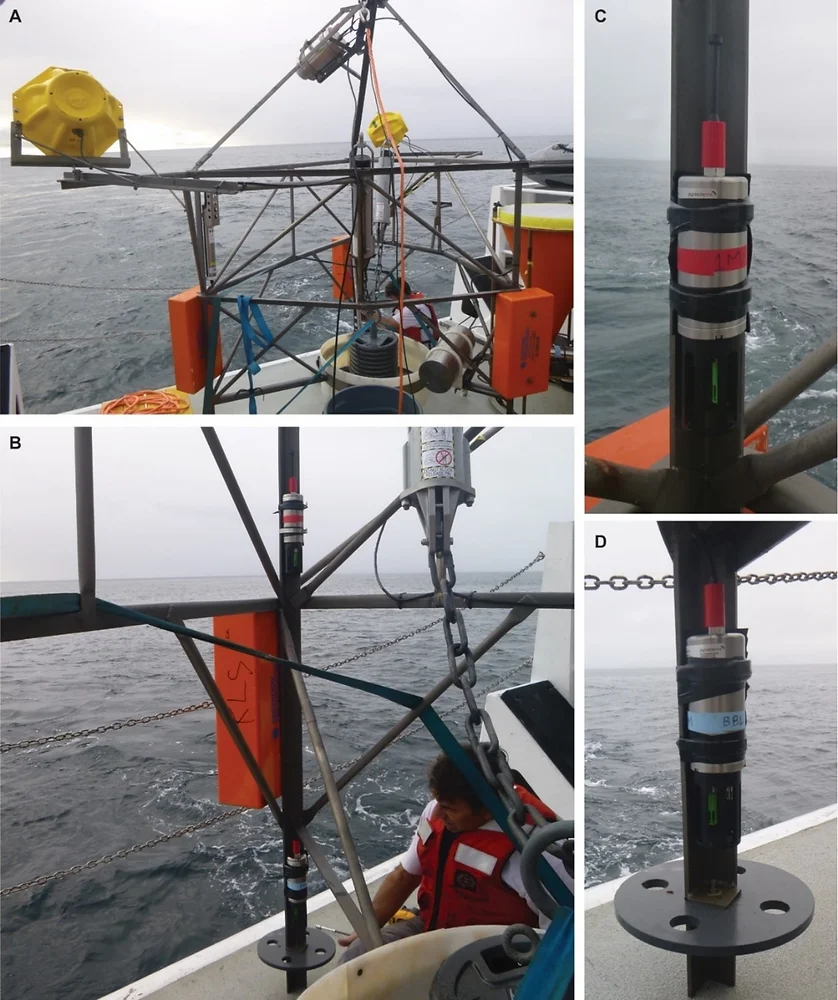
Attachment points between the AquapHOx-LX loggers, the camera frame, and hose clamps, were electronically isolated from each other using rubber padding and tape to prevent corrosion. The system was deployed on the base of a mooring on 9 October, 2021, where it sank to the bottom depth of 3963 m, and sat until recovery on 29 Sept 2022. Following nearly one year in the deep sea, loggers and sensors were in excellent condition, with no biofouling or meaningful corrosion (Figure 1). The logger near the sediment showed minor discoloration where it may have contacted rust from a hose clamp. Both instruments were recovered with significant battery (> 80%) and memory (> 95%) remaining, following almost 12 months deployed in water typically less than 1.5 °C, taking measurements every ten minutes.
A laboratory assessment of drift was performed through a combination of post-deployment calibrations and analysis of the calculated pH deviations from a modeled value at Station M. We utilized the PyroScience pH capsule buffers to carry out the recommended laboratory calibration for both dPhi 1 and dPhi 2 to compare the new calibration coefficients to the register at the beginning of the deployment for each sensor. The values for the new calibrations were inferred from the PyriScience graphical user interface due to complications in the firmware update. There was a strong positive drift in the dPhi 1 values for each sensor and a smaller positive drift for the dPhi 2 values, except for one sensor which displayed a negative drift for dPhi 2 (Table 1). In the field, we saw a positive drift of pH toward a more basic solution for all sensors, with the two benthic sensors having a drift of about ~0.1 pH units/yr using parameters from the AquapHOx loggers and oxygen data from this study site (Smith et al., 2022) to compute pH (Bittig et al., 2018).
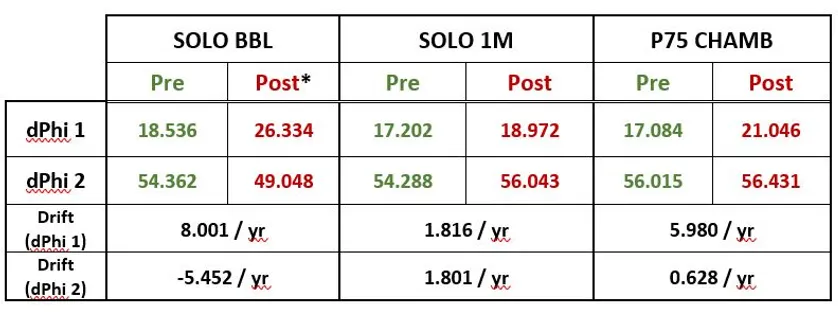
Data from these sensors provided insights into variability deep-sea pH. pH measurements taken during deployment and recovery of the system showed an increase in pH with increasing depth during the descent (Figure 6). pH appeared to stabilize in about an hour during sinking (Figure 6A, B). Both units showed similar patterns during recovery, despite undergoing drift over the course of the deployment. Low points on panels C and D are post-deployment measurements taken of the pH 2 buffer, demonstrating the inability of this sensor to record pH that low, thereby compromising the ability to evaluate any offset using the method outlined in the user manual.
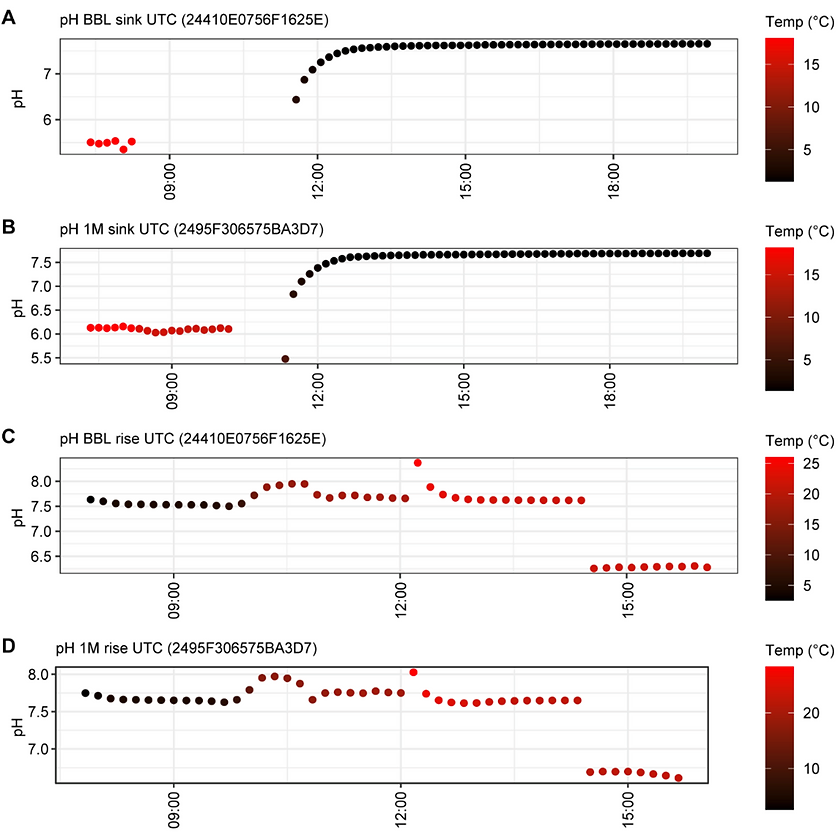
Over the course of this deployment, pH started low and gradually drifted upward (Figure 7). pH near the sediment-seawater interface was lower than that 1 m above the seafloor, though this sensor had also recorded lower values in side-by-side comparison with the other sensor on an ROV dive (Figure 3C). Despite the drift, short-term variability was evident, and possibly associated with changes in water temperature.
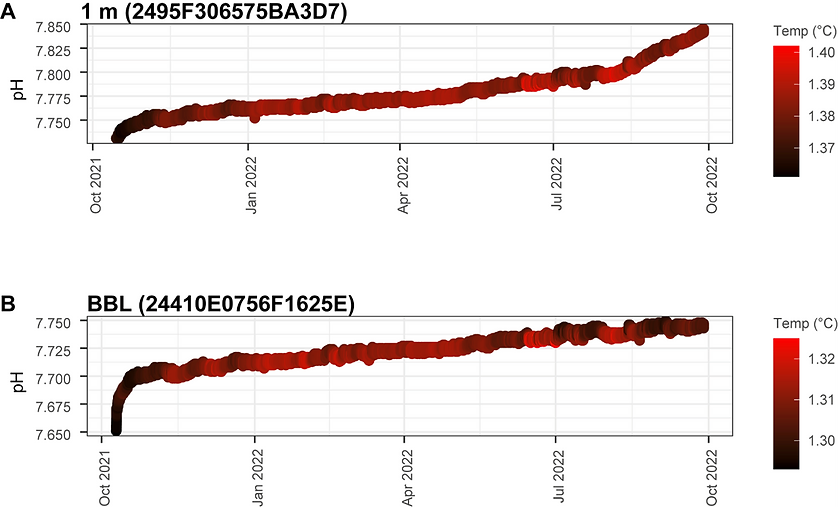
References
Bittig, H.C., Steinhoff, T., Claustre, H., Fiedler, B., Williams, N.L., Sauzède, R., Körtzinger, A. and Gattuso, J.P., 2018. An alternative to static climatologies: Robust estimation of open ocean CO2 variables and nutrient concentrations from T, S, and O2 data using Bayesian neural networks. Frontiers in Marine Science, 5, p.328.
Smith Jr, K. L., Messié, M., Connolly, T. P., & Huffard, C. L. (2022). Decadal Time‐Series Depletion of Dissolved Oxygen at Abyssal Depths in the Northeast Pacific. Geophysical Research Letters, 49(24), e2022GL101018.
Acknowledgements
MBARI’s Research Team thanks the crews of the RV Western Flyer, pilots of ROV Dock Ricketts, and John Ferreira for their critical support of instrument deployments.

